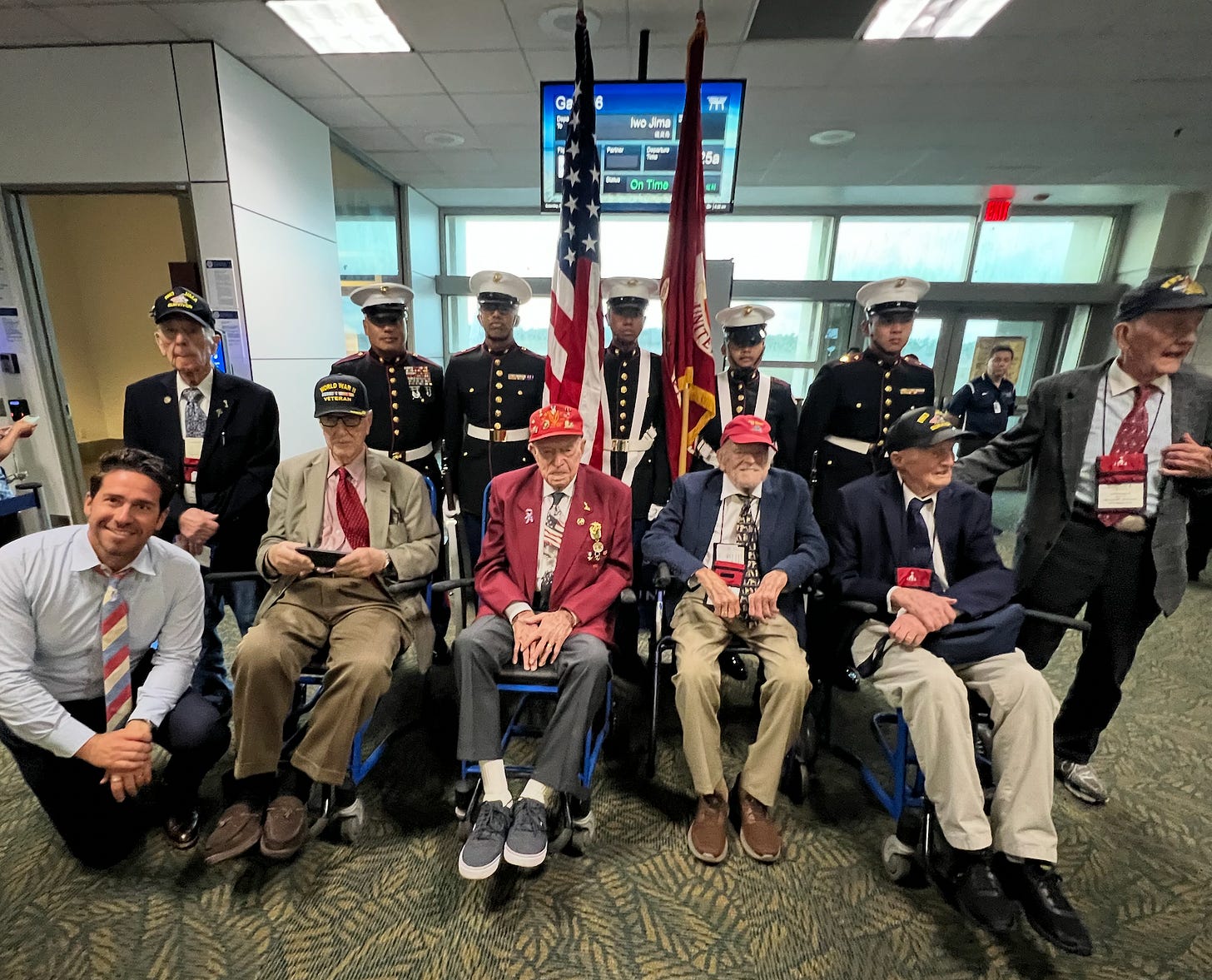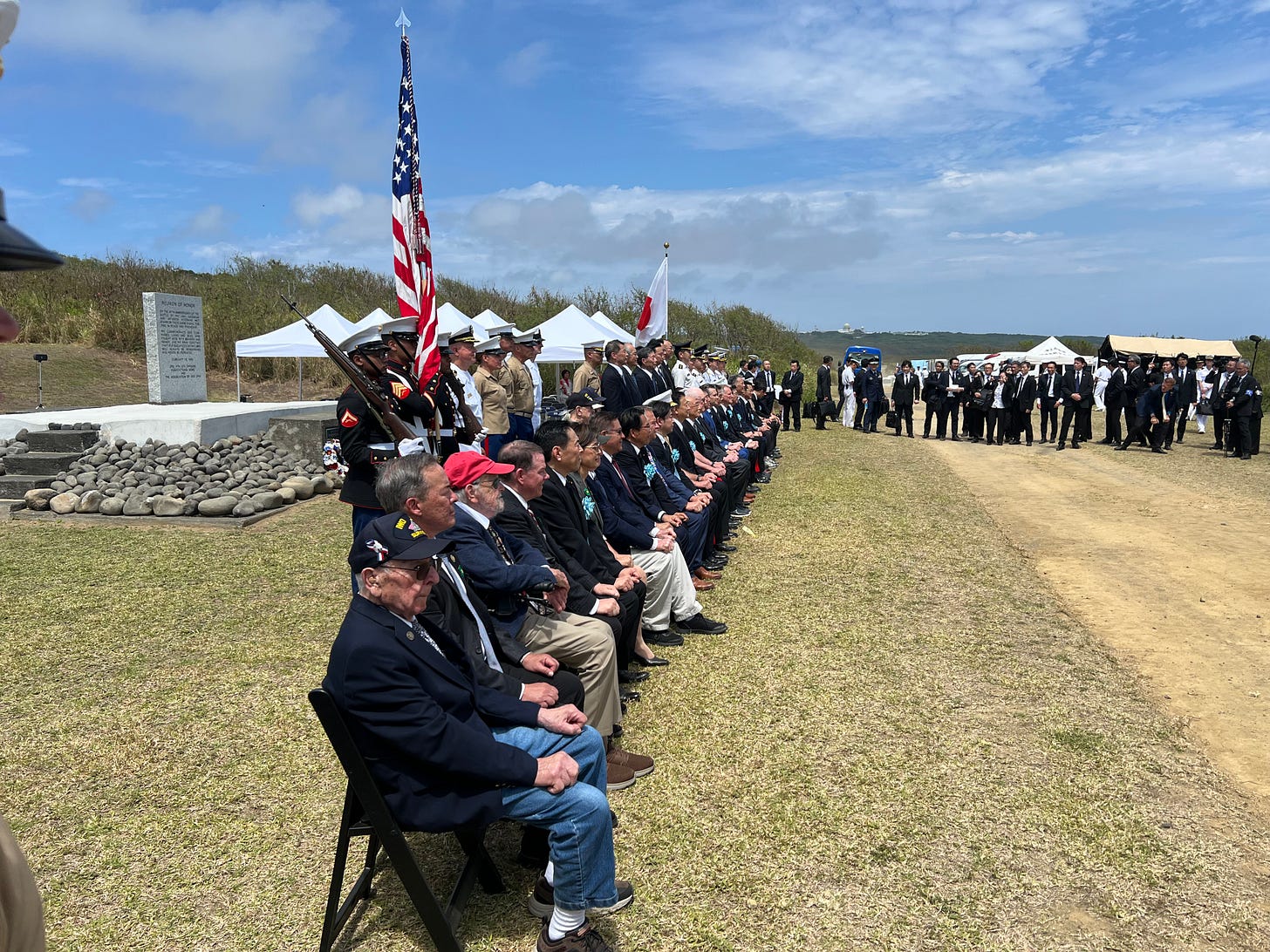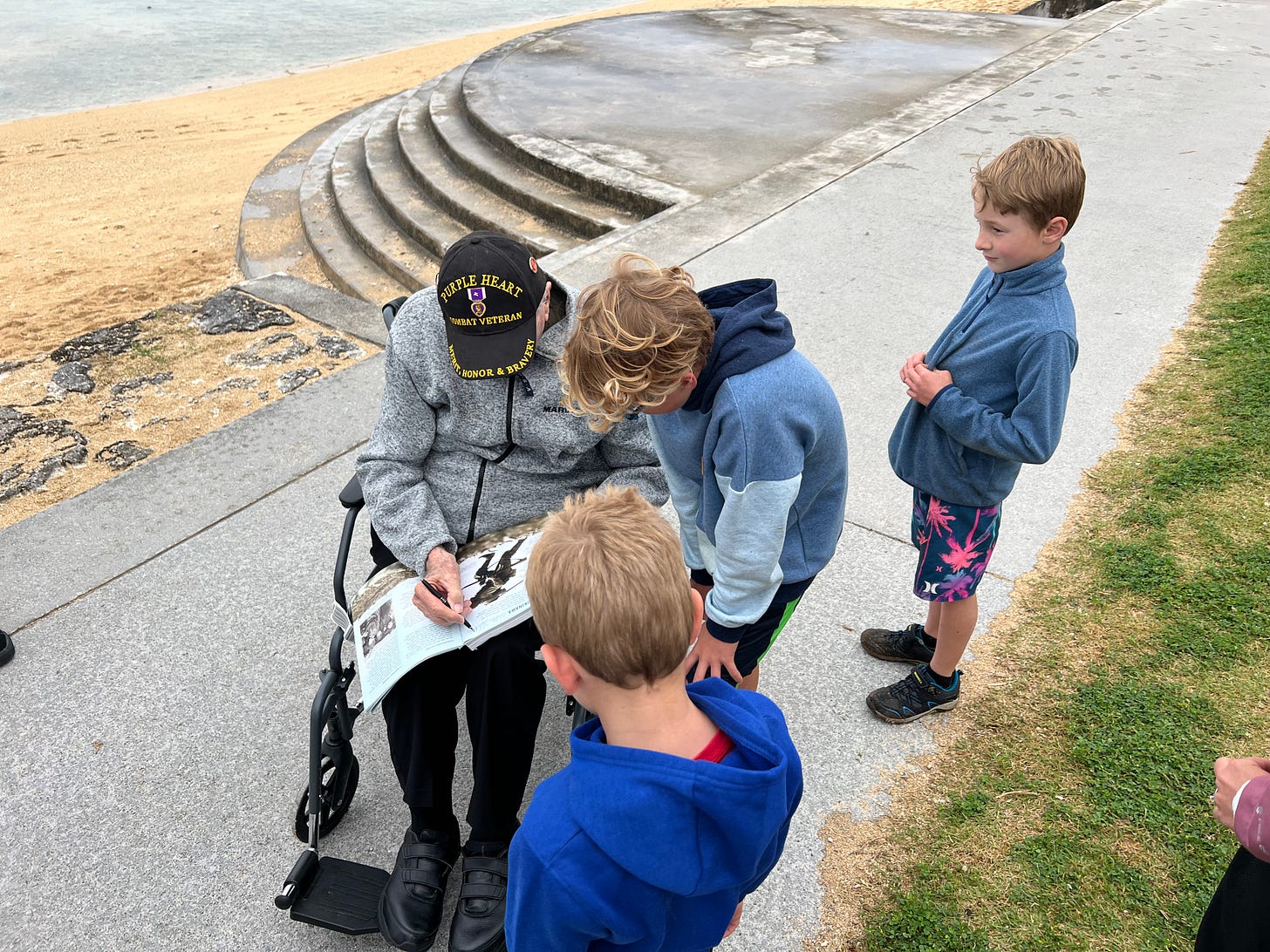If the first leg of our journey through Guam, Peleliu, and Angaur was a pilgrimage into memory, this second leg—across Iwo Jima and Okinawa—was a confrontation with raw, unflinching sacrifice.
These were crucibles as much as they were battlefields. And walking them with our veterans—especially Walter LaSota—was something none of us will ever forget.
Iwo Jima: Where the Ash Still Burns
The night before we set foot on Iwo Jima’s sacred ground, we dined with a modern warrior: Lt. Gen. Richard Mills, USMC (Ret.), a three-star general and chairman of the Iwo Jima Association of America. With a storied career spanning Iraq and Afghanistan, General Mills reminded us that the character forged on islands like Iwo still shapes America’s finest leaders. The battles may be over, he said, but the call to service never fades.
There’s only one chartered flight of Americans to Iwo Jima (now officially called Iwo To) each year. Thanks to the Iwo Jima Association of America and United Airlines, we were on it—banking in a slow figure-eight so everyone could glimpse the island where so much blood was spilled.
No civilians live on Iwo. Only the Japanese government. The soil still rises—eight feet in 80 years—due to volcanic pressure. The air smells faintly of sulfur. The island feels like it’s still smoldering. A few persons even passed out from the heat.
We landed alongside veterans and dignitaries: U.S. Secretary of Defense Pete Hegseth, the Japanese Minister of Defense, and the Prime Minister of Japan. This occasion marked the 80th anniversary of the beacon of the Pacific War – the Battle of Iwo Jima – with the moving ceremony known as the Reunion of Honor. It almost didn’t happen but a coalition of the willing wouldn’t relent.
The way Japan processes the war remains complex. There is relatively little moral clarity or public reckoning with the atrocities committed. Instead, the narrative centers on honoring their fallen for their valor, framing the war as a noble effort ultimately overpowered—reminiscent, to me, of the “Lost Cause” mythology of the American Confederacy. War crimes and the brutality of Imperial Japan are not acknowledged at each historic site. (If someone has a different view, please share.) Still, honoring the dead—on both sides—and strengthening an alliance crucial to countering the Chinese Communist Party is a vital act of modern statecraft.
We stood at the foot of Mt. Suribachi – visualizing Old Glory waving atop, as in the iconic photo – next to massive cannons dug into volcanic rock. We walked the black ash beaches—sacred ground once soaked in American and Japanese blood. Over 30,000 Marines fought here. More than 7,000 died in the first week. The island would yield 27 Medals of Honor—the most of any battle in U.S. history.
As historian Marty Morgan said: “We stood where great men once stood. They just so happen to be great men you never heard of.”
For the first time in the Pacific War, Americans outnumbered the Japanese. Still, the cost was shocking. By the end, nearly 21,000 Japanese lay dead. Fewer than 200 surrendered—and many weren’t even Japanese nationals. Enslaved conscripts.
Okinawa: The Strategic Stakes
Then came Okinawa—the final major battle of the Pacific. This wasn’t just a battle. It was a warning. From here, America would launch the invasion of Japan. The Japanese knew it, and their goal was clear: inflict such devastation that we’d back off. They dug in: honeycombed cave systems, reverse-slope defenses, and a brutal line anchored by Shuri Castle. It was medieval. And it was effective.
U.S. losses were staggering—more than 72,000 killed, wounded, or broken by battle fatigue. More sailors died off Okinawa than in any other battle in American history. Nearly 150,000 civilians were killed—many used as shields by Imperial Japan, many were misled to believe that surrender meant torture.
At one site we visited—Chibichiri Gama, now known as “Sad Cave”—83 Okinawans, including nearly many children, died by suicide, many by cyanide, rather than face what they thought of the Americans. The Japanese military had lied to them about what capture would mean. The truth came too late for them.
We toured the Japanese Naval Headquarters—tunnels blasted into stone, still bearing the scars of war. We saw how desperate the defense had become. Over 10,000 Korean laborers were forced to dig caves. Japanese soldiers hurled waste and disease at U.S. troops.
Estimates projected up to one million U.S. deaths if we invaded Japan itself. A blockade would have been comparable. One person noted that, as uncomfortable as it is to say, dropping the bombs was the most humanitarian of all the options.
It Was Personal
Walter LaSota, of the 6th Marine Division, returned to Okinawa for the first time in 80 years. He’d been trained on Guadalcanal, wounded on Sugar Loaf Hill. He visited the landing beaches with us—greeted by American children who recognized him as a hero and asked for autographs.
We climbed Kakazu Ridge with him—good workout—and stood atop ground that once rained fire. At Futenma Air Base, 50 young Marines and a two-star general gave him a ceremonial welcome. Some Marines were foreign-born, now serving in our military. They stood tall, listening to a man who had paved their path.
We received an intelligence briefing on Pacific security. The Chinese Communist Party surrounds Japan. Threats abound. The past isn’t past. Vigilance is essential.
At Sugar Loaf Hill—the site of Walter’s wounding—we saw him play out a memory in his mind that was visceral. Watching Hacksaw Ridge only gives you an idea of what must have run through his mind, body, and soul. He didn’t say much. He didn’t need to. You could feel it in the stillness. It was a moment of full-circle grace. Healing. And his daughter, standing beside him, carried it with strength and tenderness.Later, we gathered as Acheson Keller—the youngest in our group—presented Walter, the eldest, with the American flag. His father beamed. And everyone else got misty. Todd Herrick joked: “Eagle Society’s been making men cry since 2025.”
Final Reflections
This trip wasn’t just about battlefields. It was about ideas and people. We honored soldiers, sailors, marines, and medics. We honored civilians and ghosts. We honored the values they fought for—freedom, dignity, duty.
On the final night, Walter raised his glass. “Thank you, I never thought this would actually happen” he said, and it landed deeper than any toast I’ve ever heard.
It wasn’t just about looking back. It was a charge to carry it forward.
The Mission Continues
Here at Eagle Society, we don’t just commemorate the past. We leverage the power of experience to bring it to life—to steward values, awaken responsibility, and inspire a fresh patriotism grounded in duty.
If this story moved you, help us continue the mission. Share it. Support it. And join us on the next journey.
Because the best way to honor the legacy of those who fought… is to make sure it lives on in us.














